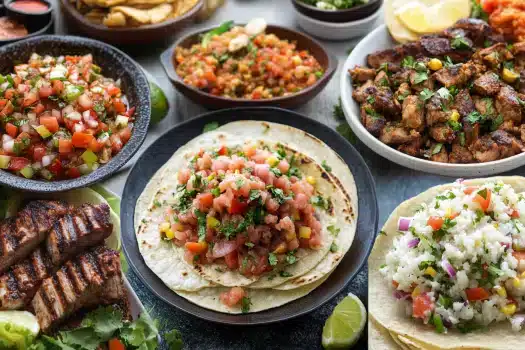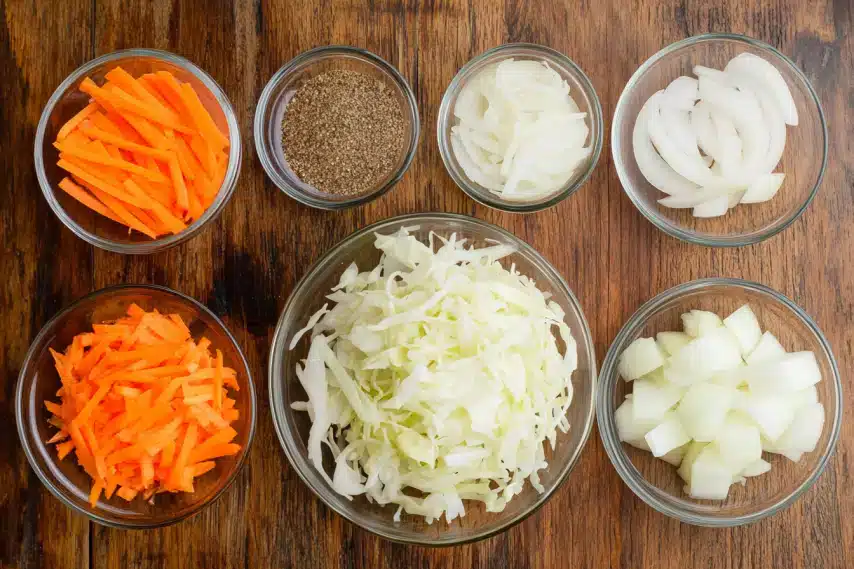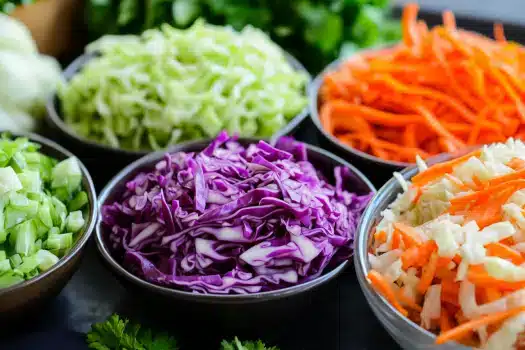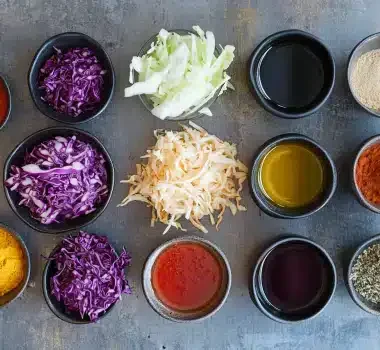Have you ever tasted the tangy and vibrant flavors of curtido and wondered, “What is curtido made of?” This popular Central American pickled cabbage is more than just a side dish; it’s a flavorful blend of simple ingredients that come together to create a culinary staple. In this article, we’ll delve into the essential components of curtido, exploring the key vegetables, pickling agents, and spices that give it its distinct taste and texture. We will also discuss the traditional methods of preparation and cultural significance of this amazing condiment. Get ready to learn what makes curtido so special!
Core Ingredients: What is Curtido Made of?
To truly understand curtido, we must start with its fundamental ingredients. So, what are the ingredients of curtido? It’s a blend of fresh vegetables, pickling agents, and a selection of spices, each carefully chosen to create the complex flavors and textures that define this dish. Let’s break them down one by one.
The Foundation: Cabbage
The main ingredient of curtido is cabbage. This is usually green cabbage, which provides a crisp texture and a mild flavor base. The cabbage is shredded thinly, to make it absorb the pickling brine, and to give it the desired texture. You may also find variations that use red or napa cabbage, and these variations will create a different taste. The way the cabbage is prepared is as important as the type, because it is key to achieve that perfect bite. That’s why the preparation of the cabbage affects the final product.
The Brine: Vinegar and Salt
The brine is what transforms raw vegetables into pickled delights, and in curtido, the main elements are vinegar and salt. White vinegar is usually the common choice, although other types of vinegar, like apple cider vinegar, are also used in order to give it another layer of flavor. Vinegar acts as a pickling agent, preserving the vegetables and giving it the tangy flavor profile. Salt is also a key element, and contributes to the preservation process, while also enhancing the overall taste of the curtido. The ratio of vinegar and salt will play a big role in the end result.
Flavor Enhancers: Onions and Carrots
Onions and carrots are key additions that provide additional flavor and texture to the curtido. The onions, usually sliced, add a sharp and savory note, while the carrots, often julienned or cut into matchsticks, add a touch of sweetness and crunch. These are the main components, but some prefer using other variations to create another kind of taste. These ingredients are not there to just add flavor, but also, to contribute to the overall profile of the curtido. The way that these elements are prepared also affects the end result.
The Spice Blend: Herbs and Spices
The addition of a spice blend is what makes every curtido different. Oregano is a common addition, giving a unique and aromatic flavor. Salt and pepper are essentials in most recipes, but also contribute to the overall flavor. Some people might also add chili flakes to add some extra heat. These spices can be adjusted according to the local tastes, and each blend will contribute to the overall identity of the dish. This is a unique dish, and the spices are a core part of its profile.
The Origins and Cultural Significance of Curtido

Now that you understand what curtido is made of, it is time to explore its origins. Understanding its history is key to appreciating the cultural significance of this unique Central American dish.
Historical Roots of Curtido
The process of pickling vegetables has a long history in Central America. This practice goes back generations, as it allowed people to preserve food. Curtido has become a staple in various countries. Over time, local ingredients were added and adjusted, giving the recipe its own unique twists. This traditional food evolved and became an integral part of Central American cuisine.
Curtido in Central American Cuisine
Curtido is not just a side dish; it’s an essential part of Central American meals. It is commonly used as a condiment and topping, and it is very often found in family meals, local markets, and restaurants. Its unique flavor is present in all kinds of occasions, from simple daily meals to special celebrations. Curtido has always been a staple in the region, and has gained the status of a classic dish.
Exploring Regional Variations: What Affects the Ingredients?
While the basic recipe for curtido remains consistent, regional variations influence the type and amount of ingredients used. Exploring these differences gives you a deeper understanding of the regional flavors.
Differences Across Countries
The way that curtido is made often varies across different Central American countries. For example, the version in El Salvador often uses more oregano, while other countries might add more spices, or add other kinds of vegetables. Each country has its own unique variations that reflect local preferences. This has created a diverse landscape of flavors and styles.
Local Adaptations and Twists
Besides country-wide differences, many local versions of curtido have unique ingredients and preparation techniques. Some regions will use other types of vinegar, or they might add a different type of cabbage. These unique touches add to the overall diversity of the dish. All these details enhance its uniqueness.
Impact of Ingredient Availability
The availability of ingredients in a particular region also plays a huge role in the local versions of the dish. If a particular vegetable is not available, then other substitutes will come to play. These changes due to availability have shaped the flavors and textures of the dish, as people have had to adapt to whatever was available in each area.
The Traditional Preparation Process of Curtido

Understanding what is curtido made of also requires an understanding of the preparation process. The way curtido is made is also key to achieving that unique flavor and texture.
Preparing the Vegetables
The vegetables need to be properly prepared for the pickling process. The cabbage needs to be thinly shredded to ensure that it absorbs the pickling brine, and the carrots and onions need to be sliced to ensure that they are equally pickled. The way that each vegetable is cut will define the overall texture and make each bite unique. This is an essential step in the process.
Making the Brine
The brine is made by combining vinegar with salt and spices. The ratio will differ depending on the preferences, but the main goal is to create a base that will provide the required acidity to pickle the vegetables. The type of vinegar also influences the flavor and has a big impact on the end result. This is where the magic happens, and the pickling process begins.
The Pickling and Fermentation Process
The final step involves mixing all the vegetables with the brine and packing them into a clean container. The fermentation process is key to developing the tangy flavor. The time needed will depend on the desired result, and the curtido can be stored in the fridge once done. This is an essential process that takes patience but results in a delicious dish.
Exploring Alternative Ingredients: What Can You Add to Curtido?
Now, let’s explore some options on how you can get creative with your curtido. There are a lot of options when using alternative ingredients, so this is your chance to explore.
Using Other Types of Cabbage
If you wish to experiment, you can always use other types of cabbage, such as red or napa cabbage. Red cabbage brings a vibrant color, and a different flavor profile, while napa cabbage brings a softer texture and a delicate taste. These different options allow you to create a unique version of curtido, which shows that you can definitely adapt it to your own tastes.
Introducing Additional Vegetables
Feel free to add other vegetables, such as cauliflower, radishes, or bell peppers. These veggies add different textures and flavors that will enhance the overall experience. This will create a more complex and interesting cabbage salad. There are a lot of options that you can explore when creating a homemade curtido.
Adjusting Spices and Herbs
You can also experiment with different spice and herb combinations to create unique flavor profiles. You can try adding cumin, smoked paprika, or even some dried herbs. Always feel free to experiment and find the best combination for you. This approach gives a lot of flexibility, and also gives you the freedom to create a personalized dish.
Serving Suggestions and Culinary Uses of Curtido
Curtido is more than just a side dish, and has many applications. Let’s explore all of its versatility.
Curtido as a Condiment
Curtido is a great condiment, used in a variety of dishes. It is the perfect topping to add a tangy and crunchy kick to different meals. It is served on the side, but also, on top, so be sure to use it as a way to enhance flavors. This is why this dish is present in so many meals.
Traditional Food Pairings
Curtido is traditionally paired with dishes such as pupusas, tacos, and grilled meats. Its tangy and refreshing flavor perfectly complements the savory and richness of these dishes. These are classic pairings for a good reason, and should be a must in your meals. This is why this dish is very popular in Central American cuisine.
Creative and Modern Uses
Curtido is a great addition to salads, sandwiches, and other dishes that need a tangy or crunchy component. You can use it in so many other meals, and always have amazing results. This is a versatile ingredient, and you can use it in many creative ways, as a side or main ingredient.
Nutritional Information and Health Aspects
Curtido is not only delicious but also offers many nutritional benefits. Let’s explore what it offers in terms of health.
Nutritional Profile of Curtido
Curtido is rich in vitamins and minerals from the fresh vegetables used in the recipe. Cabbage provides vitamins C and K, while carrots are a good source of vitamin A, also providing dietary fiber. These ingredients combined are great for your overall well-being. Adding this side dish to your meals is a great way to have a more balanced diet.
Probiotic Benefits
Curtido, as a fermented food, is a great source of probiotics, which are beneficial bacteria that contribute to gut health. These probiotics improve the digestion and help the immune system, which is essential for overall well-being. Having fermented vegetables in your meals is a great way to enhance your health, and can improve your digestive system.
Potential Health Considerations
While curtido offers many health benefits, it is important to be mindful of the salt content, as it can be high in sodium. Also, since it is a fermented vegetable, it might cause discomfort in some people with sensitive digestive systems. Always be sure to consume curtido in moderation, and as a part of a balanced diet.
You can find more information about making pickling brines on www.sublimecake.com and www.allrecipes.com.
What is Curtido Made of? FAQs
Let’s wrap up by addressing some frequently asked questions about curtido. These will help clarify any doubts you might have.
Common Questions About Curtido
- FAQ 1: What is the main ingredient in curtido?
- The main ingredient in curtido is cabbage, usually green cabbage.
- FAQ 2: What kind of vinegar is best for curtido?
- White vinegar is commonly used, but apple cider vinegar is also a great option.
- FAQ 3: Can you make curtido without salt?
- Salt is necessary in the pickling process so it is not recommended to omit it.
- FAQ 4: What gives curtido its tangy flavor?
- The tangy flavor comes from the vinegar used in the pickling process.
- FAQ 5: Is curtido spicy?
- Curtido has a mild spice level, but you can add chili flakes for more heat.
- FAQ 6: How long does homemade curtido last?
- Homemade curtido can last for up to two weeks when stored in the refrigerator.
- FAQ 7: Is curtido a healthy food?
- Curtido is rich in nutrients, probiotics and is a great addition to a balanced diet, when enjoyed in moderation.
Conclusion
Curtido is a testament to how simple ingredients can come together to create a complex and delicious dish. What is curtido made of is more than just a question about ingredients, but a deep dive into the history and culture of Central America. Its unique flavor and versatility make it a beloved dish, and a cultural icon that is loved and appreciated by many.thumb_upthumb_down.






